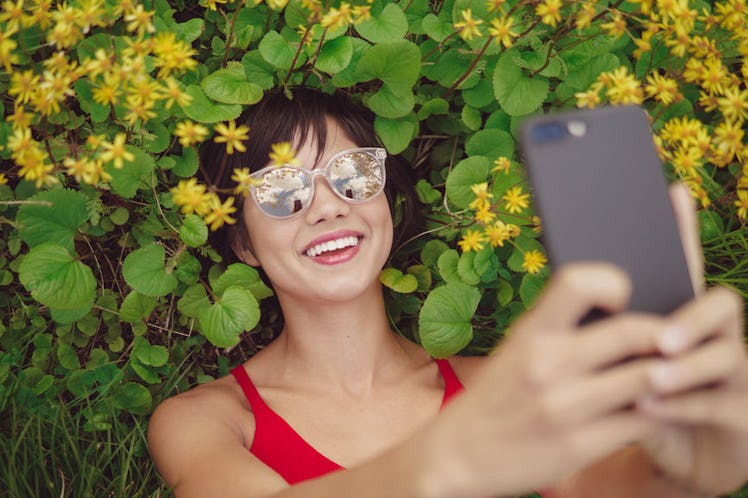
The Psychology Behind Gatsbying, According To A Dating Expert
It’s no secret that social media has totally transformed the way we date — and the way we flirt. Gone are the days when you had to agonize over what to text your crush (or, you know, dial someone's digits and speak) just to figure out if the interest was mutual. Now, you can just slap a flattering filter and a cute caption on a selfie and wait for them to react. As it turns out, there’s a term for this clever little tactic: “Gatsbying.” But what is the psychology behind Gatsbying? Why do we do this? And is there a downside to it?
Odds are, you may have unknowingly used this approach, whether via an Instagram post or Snapchat story, in hopes of getting that sought after “like” or comment from the object of your affection. But in the interest of clarification, let’s review what Gatsbying is. If you read F. Scott Fitzgerald’s classic novel The Great Gatsby, or perhaps saw Baz Luhrmann's 2013 film adaptation starring Leo DiCaprio, you may recall that Jay Gatsby literally dedicated all of his energy to planning lavish parties to impress his crush, Daisy Buchanan. Unlike Gatsby, most of us A) don’t have the funds to throw these elaborate shindigs and B) have social media at our disposal. So, instead of going all-out on a rager with an open bar, you upload a picture that you’re confident will capture your crush’s attention, and furthermore, inspire them to hit that like button or leave a flirty comment so you know the interest is mutual.
To be clear, this approach is entirely different than posting a pic in hopes of racking up a lot of likes overall. Unlike setting a thirst trap, Gatsbying is a targeted attempt to win over one specific individual. As for why someone might resort to this strategy over, say, DM’ing their crush, online dating expert and digital matchmaker Julie Spira says it’s typically because there’s less risk involved.
“Posting that photo of you looking your best, a picture of a place you know you crush likes, or their favorite dish provides a passive way of getting their attention and gauging their interest without the fear of instant rejection,” she explains.
This totally makes sense. Whether or not your crush reacts to your photo, you can pass it off as a public post without experiencing much of an ego blow. Sure, it might be a bummer if they don’t like it or comment on it, but it’s a lot easier to swallow than if they don’t respond to a personal message. Basically, we’re all cowards (thanks, technology).
It may seem like an easier way to spark some flirting without risking rejection, but Spira says there are some problematic factors with Gatsbying. For one, she says that it places too much emphasis on the meaning behind a social media exchange. Real talk: How many times have you mindlessly scrolled through your feed and hit “like” on a photo without thinking about it? So, it’s safe to say that just because someone tapped the heart button on your pic doesn’t mean they’re fantasizing about being your bae.
“Liking and commenting may give you a false sense that someone is interested in you,” says Spira.
Just as someone’s like or comment doesn’t guarantee that they’re into you, Spira notes that someone’s lack of response doesn’t mean they aren’t. If you put in a lot of effort to catch your crush’s eye, and they don’t respond, that could potentially backfire and fuel some unnecessary insecurities about their feelings. They may very well be interested but not have seen the photo. Or, Spira points out that if they’re not big on social media, then your Gatsbying efforts could be in vain.
According to Spira, people very often resort to Gatsbying in order to seduce their ex into wanting them back (or, you know, just to prove a point about how fab their life is now).
“People who break up use this method of staying connected by posting photos looking fabulous on vacation, or at a place they used to go to with their ex, to see if they still care — or to keep the door open in case they might get back together in the future,” she explains.
So, is Gatsbying an effective approach to flirting?
“If you build up the attraction of a potential suitor by gradually becoming a part of their day through social media, it’s a way of slowly courting, but you still might remain in the friend zone,” says Spira.
If the old saying goes “out of sight, out of mind,” then it seems logical to say that regularly popping up on your crush’s Instagram feed with some like-worthy posts might make them think about your more. In other words, at its best, Gatsbying offers the chance to capture your crush’s attention, as well as perhaps hint at the possibility that they like you. But at its worst, Gatsbying could give you false hope, or conversely, an inaccurate perception that they don’t like you.
Ultimately, social media isn’t really a solid measuring system for someone’s interest. You probably don’t give too much to your likes and comments, so it’s safe to assume that your crush doesn’t, either. That said, as long as you can manage your expectations, there’s no harm in a little Gatsbying now and then. If it gives you the boost of reassurance you need so you can build up the courage to ask them out, then go for it. Taking direct action — whether by shooting them a flirty text or (gasp!) asking them out for drinks IRL — may feel vulnerable, but it could also lead to a greater sense of reassurance about their feelings. And as they say, no risk, no reward.